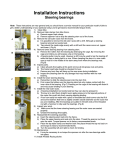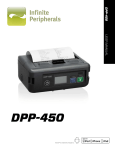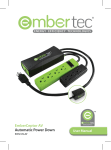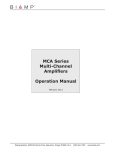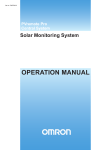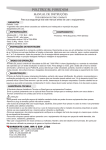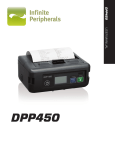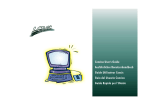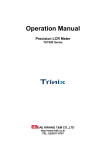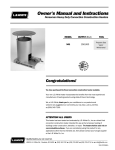Download Series L,LM & LB OM. rev
Transcript
Owner’s Manual Assembly, Operation and Service Manual for Series L, LM and LB Ball Bearing Power Tools and Handpieces For Your Own Safety: • Read Owner's Manual before operating your Foredom Power Tool. • Always wear eye protection while using power tools. • Always use dust collection, respirator, or face mask to prevent inhalation of dust particles from workpiece or abrasives. • Only use accessories rated for use at the maximum speed (5,000 RPM) of these tools. FOREDOM ® Contents Page Safety Instructions 1 Foredom Tools 3 Assembly Instructions 4 Assembly and Adjustment of Flexible Shaft, Sheath and Handpiece 4 Connecting Foot or Manual Speed Controls 5 Installing and Attaching Accessories 6 General Accessory Requirements 8 Operation Series L, LM, and LB 10 Maintenance Routine Cleaning and Lubrication 11 Replacement of Motor Brushes 11 Replacement of Worn Shaft and Sheath 11 Handpiece Lubrication 11 Other Service and Repair 12 Recommended Spare Parts and Supplies 13 Limited Warranty 14 Owner’s Registration Card 14 For More Information 14 Safety Instructions • Before using your Foredom® power tool, please read safety instructions.They are for your protection and should always be followed to reduce the risk of personal injury or damage to the tool. Always wear proper eye and face protection. Safety glasses or face shields should be worn whenever you operate a Foredom or any power tool to prevent serious eye or face injuries. • Always use a proper dust collection system or wear a respirator to prevent the inhalation of dust particles or other debris into your lungs. • Do not wear loose fitting clothing or jewelry. Loose clothing or jewelry can become entangled in the rotating bur. Do not wear items such as neck ties,necklaces, or bracelets when operating power tools. Be sure to tie back or secure long hair. • Secure power tool to motor hanger or work surface. Substantial torque is generated when starting or accelerating it with the foot pedal. Securely attach it to the motor hanger to prevent it from “jumping off” the hook. 1 • Never operate any accessory at speeds above it’s maximum rated speed. All of Foredom's accessories, when properly used, can be operated at the speed ratings listed in the Foredom Accessory Catalog or on the accessory kits and packages. Always find out the manufacturer's speed rating before using other accessories. • Never use or continue to use any accessory which appears to be damaged, loose, vibrat ing, or out of balance. Inspect each accessory for cracks or flaws before using it. Avoid knots, imperfections in the wood or metal objects like nails, which could damage or catch the accessory. Let the speed of the tool do the work rather than apply heavy pressure to the accessory. • Always insert the shank or shaft of an accessory or mandrel into the collet or chuck of the handpiece as far as possible in order to provide proper support and tighten the collet or chuck securely. • Never use excessive side pressure which may tend to bend or break the shank or shaft of an accessory. Let the speed of the accessory do the work. • Do not stall the motor by jamming or using excessive pressure on the accessory. This can result in damage to the motor or flexible shaft. • Never operate the motor with the outer sheath removed from the flexible shaft. • Always disconnect the power cord before servicing the motor or removing the flexible shaft or sheath. • Never operate your power tool during a perceptible power decrease. Turn power tool off and do not use until power is fully restored. • Use proper grounding procedures. This tool should be grounded while in use to protect the operator from electric shock. The tool is equipped with an approved 3-conductor cord and plug to fit the proper grounding receptacle. The green (or green and yellow) conductor in the cord is the grounding wire. Never connect the green wire to a live terminal. It has a plug that looks like sketch A in the diagram below. An adapter, sketches B and C, can be used for connecting plugs as shown below to 2-prong receptacles. The green colored rigid ear, lug, etc., extending from the adapter must be connected to a permanent ground such as a properly grounded outlet box. Use only 3-wire extension cords that have 3-prong grounding type plugs and3-pole receptacles that accept the tool's plug. 2 Foredom Power Tools Covered in this Manual You have purchased a fine quality power tool which will perform a wide variety of tasks difficult to do with any other kind of power tool. Foredom power tools are manufactured to high standards of precision and performance and, with proper use and regular maintenance, will give you years of trouble-free performance. This instruction manual contains instructions for the assembly, operation and servicing of the Foredom power tools shown below. Series L Series LB 3 Series LM A complete Foredom flexible shaft power tool consists of a motor, flexible shaft and sheath, speed control (foot or manual) and a handpiece. Locate and identify all components, parts and accessories you purchased before discarding the packing list and packing materials that came with your power tool. An Owner's Registration Card and this Owner's Manual should also accompany each power tool. Additional copies will be sent to you upon request. Send your Owner's Registration Card to Foredom right away. Assembly Instructions Always make sure your power tool is unplugged during assembly! After identifying all the components of your power tool, it should be assembled in the following manner: Assembly and Adjustment of Flexible Shaft, Sheath, and Handpiece Proper assembly and adjustment of the flexible shaft and sheath are critical for the correct operation of your Foredom power tool. The exposed tip (handpiece end) of the flexible shaft (with hand piece removed) must extend 3/4″ beyond the sheath. IMPORTANT! Important Note: The shaft and sheath should be checked and adjusted (if necessary) even if you received them assembled and attached to the motor! Please follow the directions below to assemble and adjust the shaft and sheath. To check the shaft and sheath you must first remove the handpiece. 1.The handpiece is easy to remove from the flexible shaft.To remove, simply pull the handpiece off the shaft and sheath with a firm grip. To re-attach, be sure that the keyed tip of the flexible shaft is properly lined up with the slot in the back end of the handpiece by looking into the rear of the handpiece before pushing it on. If it is not in line, turn the shaft tip or the handpiece to the correct position (see illustration below). 2. Place the entire unit on a flat surface with the shaft and sheath extended straight. Loosen the set screw on the motor connector. Adjust the exposed tip (handpiece end) of the flexible shaft so that it extends 3/4″ beyond the sheath, as shown in illustrations above. This is done by moving the sheath in or out of the motor connector. 3. When the correct adjustment is made, re-tighten the set screw in the motor connector and re-attach handpiece onto the flexible shaft. 4 Connecting Foot or Manual Speed Control The electrical specifications for your power tool are listed on the motor nameplate. It will show the proper voltage and currents to use with your power tool. Be sure to follow the grounding instructions on page 2 of this manual while attaching either the speed control or motor to a power outlet. The 115 Volt, 50/60 cycle (Hz) L and LM Motors can be used with the models SCT-1 and FCT-1 foot controls on 115 Volt AC current only. The 230 Volt, 50/60 cycle (Hz) motors can be used with the models SCT-2 and FCT-2 foot controls on 230 Volt AC current only. Connect the foot control to the motor by inserting the 3-prong plug on the end of the motor power cord into the socket connector on the shorter power cord on the foot control. With the motor on/off switch in the “off ” position, plug the 3-prong plug on the longer power cord from the foot control into a proper 3-wire power outlet (see page 2). Make sure that you are holding the handpiece securely in hand, put the motor on/off switch in the “on” position so that your power tool is ready for operation. socket connector for motor plug 3-prong plug connects to wall outlet The L and LM Motors can also be used with the EM-1 (115 volt) or EM-2 (230 Volt) manual dial speed control on AC current. Connect the control to the motor by inserting the 3-prong plug on the end of the motor power cord on the manual control. With motor on/off switch in the “off” position and the dial indicator arrow also in the “off” position on the control, plug the 3-prong plug on the longer power cord from the manual control into a proper 3-wire outlet (see page 2). Making sure that you are holding the handpiece securely in hand, put the motor 3-prong plug on/off switch in the “on” position so that your connects to wall outlet power tool is ready for operation. socket connector for motor plug Installing and Attaching Accessories to Handpieces Directions for attaching accessories to handpieces vary according to the type of handpiece being used. Locate the model number of your Foredom handpiece from the illustrations on page 6. Attach the accessory according to the directions on page 7. 5 FOREDOM Handpieces ® 20 8 8D 28 10 30® 10D 35 15 44T 15D 52 18 52D 18D 25 25C 6 Attaching Accessories to Handpieces Directions for attaching accessories to handpieces vary according to the type of handpiece being used. Locate the model number of your Foredom handpiece from the illustrations on the previous page. Attach the accessory according to the following: Collet Types 8, 8D, 25, 28, 28SJ, 35, 35SJ, 44T, and 44TSJ General Directions: Be sure to use the correct shank size. The correct shank will fit snugly inside the collet. Caution: Never tighten a collet unless an accessory has been inserted. Tightening an empty collet or inserting an accessory which is too small or too large may damage the collet. Changing Collets in Nos. 25, 28, 28SJ, 35, 35SJ, 44T, and 44TSJ Handpieces: 1.Insert pin provided into the pilot hole and through the spindle hole (turn spindle to align holes). Apply wrench and unscrew chuck nut by turning counter-clockwise. 2.Remove chuck nut to expose collet. 3.Pull collet out of handpiece spindle. 4.Slip new collet in place and screw on chuck nut. Pilot/ Spindle Hole Nos. 8, 8D Handpieces: Pull back chuck guard sleeve to uncover the lower portion of the spindle. Insert one wrench provided into the spindle and chuck nut to loosen spindle with the other wrench. Loosen chuck nut. Insert accessory shank as far as possible into the collet. Tighten chuck nut. Test for a secure hold by pulling on accessory. To release an accessory, follow the same steps. Accessories can be released when chuck nut is ready to be loosened. If accessory does not run true, loosen chuck nut, rotate accessory, and retighten. Nos. 25, 28 and 28SJ, 35, 35SJ, 44T, and 44TSJ Handpieces: To insert or change accessories, insert pin provided into the pilot hole and through the spindle hole (turn spindle to align holes). Loosen chuck nut slightly with wrench provided. Insert shank of accessory into collet. Tighten chuck nut with wrench, keeping pin in pilot hole. Test for a secure hold by pulling on accessory. Remove pin. Chuck Type — Nos. 25C, 30®, and 30SJ Handpieces: These handpieces have Jacob's® type chucks. Open chuck jaws as far as necessary with key provided. Insert shank of accessory into the chuck as far as possible. Tighten jaws with chuck key until accessory is secure and centered. If accessory does not run true, reopen jaws, rotate accessory and retighten. To release accessory, simply reopen chuck jaws with key and pull out accessory. Hammer Type — Nos. 15, 15D, and 15SJ Handpieces: These handpieces have a threaded spindle. Thread anvil or stylus into threaded spindle as far as it will go with clockwise motion. Insert pin provided into cross hole in anvil or stylus. Tighten and remove pin. To release accessory, insert pin into the cross hole and unthread. Quick Change Type — 10, 10D, 18, 18D, 18SJ, 20, 52, 52D, and 52SJ Keep an accessory in these handpieces at all times, during both operation and storage. Nos. 10 and 10D Handpieces: These handpieces operate only when a 3/32″ shank bur is inserted. It will lock if bur is not inserted. To insert bur, move lever 180º clockwise towards the back (shaft connection end) of handpiece. Insert or change a 3/32″ shank bur and move lever 180º forward. Make sure lever is completely locked into the forward position. 7 Nos. 18, 18D, and 18SJ Handpieces: These handpieces have a lever on side of handpiece. Push the spring loaded lever in to open collet and release the shank of accessory (3/32″ only). Insert accessory while holding the lever down. Never push lever down while handpiece or flexible shaft are rotating. No. 20 Handpiece: This handpiece has a lever action collet release mechanism. Wait for the motor, flexible shaft and accessory to come to a complete stop before turning the lever to open collet and remove or insert accessory (3/32″ only). Turn lever 90˚ to left or right to open collet and change an accessory. To close the collet turn the lever back to the position parallel to the handpiece. Nos. 52, 52D, and 52SJ Handpieces: These quick change handpieces have a unique push/pull collet chuck release mechanism for rapid accessory changing (3/32″ only in 52 and 52D). Wait for the motor, flexible shaft, and accessory to come to a full stop before opening the chuck. After accessory has stopped rotating, pull the outer grip forward with one hand while holding the back of the handpiece with the other. Remove the accessory and insert the shank of the new one at least 1″ (25mm) into the chuck. Pull the grip all the way back until the chuck snaps closed. Handpiece Lubrication (See page 6 for handpiece photos.) Numbers 8, 8D*, 18, 18D*, 20, 25, 25C, 28, 30 , 35, 44T, and 52: These handpieces have been permanently lubricated with greased-shielded ball bearings and should absolutely not be lubricated. ® Number 10: Lubrication should not be required for the first 2–3 months of continuous use. Then, approximately every two weeks, remove the sheath connector (it has a standard right hand thread) to expose the slotted shaft connector and back of handpiece spindle. Clean off any dirt or old lubricant. Apply only 1 or 2 drops of Foredom oil to the spindle where it attaches to the slotted shaft. Now replace sheath connector. Number 10D* Handpiece with Duplex Spring Connection: Approximately every 20 hours of operation apply 1 or 2 drops of Foredom oil into the hole in the duplex spring collar next to the sheath connector. This will provide sufficient lubrication for both the duplex spring connection and the handpiece spindle. Numbers 15 and 15D*: Before disassembling, clean off any dirt to prevent foreign matter from falling inside the handpiece. Remove the threaded nosepiece assembly carefully with wrench supplied by turning counterclockwise (right-hand thread). Put two drops of Foredom oil into the bottom of the threaded hole of the housing and one drop into the nosepiece assembly. Replace the nosepiece assembly, hold the handpiece upright and run it slowly to distribute the oil. Lubricate every 100 hours of use. *Note: All handpieces marked with asterisk have duplex spring connections (flexible springs in middle). These connections must be lubricated once every 20 hours of operation. Apply about two drops of oil into the hole on the rear of the connection collar. This should be done with Foredom® Hypodermic type oiler (Part No. 10005). General Accessory Recommendations The wide assortment of Foredom® accessories makes your flexible shaft power tool very versatile. Grinding, sanding, carving, engraving, brushing, cutting, buffing and polishing can all be easily accomplished. Choose the right accessory for your applications from the Foredom Accessory Catalog. You may purchase accessories from your local dealer, or contact: The Foredom Electric Co. 16 Stony Hill Road, Bethel, CT 06801, (203)792-8622; or on-line at www.foredom.com. Always let the speed of the power tool do the work. Avoid forcing the tool or applying too much pressure. Experience will help you choose the right speed for the work you are doing. It's always 8 a good idea to practice on scrap pieces of the same materials you plan to work on to determine the best accessories and speeds to use. Always follow the manufacturer’s RPM or speed recommendations when selecting accessories. Your Series L, LM, or LB motor is supplied with a variable speed control so that you can operate it at the most suitable speed for each job. The motor has a maximum speed rating of 5,000 RPM. Always use an accessory which has the same or a higher rating than your tool. Using an accessory with a lower rating can result in serious injury. 1. Abrasive Points, Wheels, and Discs: Foredom’s unique CeramCut Blue Stones are made from a mixture of special man-made ceramic grain and aluminum oxide bonded together. The ceramic grain provides a faster cutting action and is more durable so that shapes are maintained longer than pure aluminum oxide stones. They are ideal for use on any hard metal such as steel, stainless steel, platinum and titanium as well as on wood. Use Silicon Carbide (green color) for low-tensile, brittle or “smeary” types of metals such as aluminum or brass. They are also ideal for use on any hard metal such as steel, stainless steel, and titanium, as well as wood. Use Aluminum Oxide (red color) for fast cutting on high-tensile, tough materials such as steel and malleable iron. Also use on glass and porcelain, etc. Aluminum Oxide (white color) points have an extremely fine grit for producing a fine, high finish on high-tensile materials including gem stones, stainless steel, and glass. Rubber Bonded Abrasive Wheels are used for removing rust and for polishing with various grits. For best results, use finer grits for finishing at high speeds and coarser grits for stock removal at lower speeds. 2. Burs and Cutters: Vanadium Steel Cutters are suitable for all materials except hardened steel and glass. Use Carbide Burs on wood, plastic and tough alloys. Carbide is generally referred to as the “hardest man-made metal”. Engraving Burs are used for fine detailed work on metal and other hard materials. Generally, use medium speeds for stock removal. Higher speeds are required for finishing work and for the smaller points. Typhoon Carbide Burs provide very fast and aggressive material removal and are specifically made for use on soft and hard woods and plastics (do not use Typhoon burs on metal). 3. Sanding Drums, Bands, and Discs: These accessories are used for removing rust, smoothing rough surfaces and for sanding jobs on wood, plastic and metal. (Avoid using too much pressure which will cause clogging or a build-up on the work surface.) For best results, use medium speeds for coarser grits and larger diameters. Use higher speeds for finishing work or with smaller sizes. 4. Cotton or Felt Bobs and Buffs: Solid Felt Buffs or Bobs are used in combination with gritty or smooth compounds for a variety of buffing and polishing operations on plastic, wood, and metal. They vary in shape and come in three hardnesses — medium, hard, and rock hard. Loosely-stitched Soft Cotton Buffs are used for delicate work; with precious metal and during polishing operations. Generally, use high speeds for cutting down and buffing. Medium speeds are used for delicate, precise work and for polishing. 5. Brushes: Miniature power brushes are generally used on metal surfaces and hard-to-reach areas. They are ideal for deburring, surface finishing, edge blending, roughening to create a good bonding surface, and general cleaning. Use high speeds for cleaning and deburring. Medium speeds are needed when cleaning hard-to-reach areas and edge blending. ® ® 9 6. Diamond Burs: Diamond Burs are used to remove stock from extremely hard materials such as tungsten and tantalum carbide cutting tools, dies and molds, broaches, and for lapping and polishing synthetic jewels and precious metals, fiberglass and reinforced plastics, PVC and ceramics. 7. CW Polishing Wheels: These longer-lasting rubber wheels impregnated with unique ceramic abrasive grain are for finishing and polishing all hard and soft metals, precious metals, and plastic. CW Wheels are available in 120 –1500 grit. See the Accessory Catalog 350 or www.foredom.com for other accessories offered by Foredom, i.e. Ruby Carvers, Tungsten Carbide Burs, Sanding Cartridge Rolls, etc. Operation – General Guidelines Read all the safety instructions in this manual before operating your Foredom® Power Tool. Proper eye and face protection must be worn to protect you from injuries caused by flying debris, chips, or sparks which might result from the work being done. Your Foredom motor may be operated in a vertical or horizontal position, but it should not be enclosed or confined so as to restrict air circulation. If the motor is hung up above a workbench, be sure it is fastened securely to the wall or motor hanger. The motor may develop a high operating temperature (up to 100oF + ambient) after prolonged use, and it will be too hot to hold. This will not harm the motor which is designed to operate at this temperature for prolonged periods. Do not bend at tight angle. Do Not Shafts and sheaths last longer when they are used without sharp bends. If used at angles or loops, wear Do This! will occur at the points of greatest friction. When operating your power tools be careful not to bend the flexible shaft too much at either the handpiece or motor shaft connections. Excessive heat and wear will occur if the bend is too great. 4″ radius Follow these guidelines for trouble-free use: a 4″or larger radius, as shown below, should be maintained for shafts on all motors. In its Minimum normal curved position All Foredom TX, CC, S, SR, and L Series Operating flexible shaft power tools can tolerate up to 12 lbs. of torque (the Radius Series TXH 1/3 horsepower can withstand 28 lbs. of torque before breaking). There is no way to avoid ultimate wear and under normal conditions a flexible shaft machine may require several replacement shafts and sheaths during its lifetime. (Follow shaft and sheath assembly instruction in the Assembly section of this manual.) Do not force the tool Let the speed of the tool do the work. Avoid using too much pressure. 4″ radius Generally, slower speeds are used for rougher, heavier work or when 10 greater control over the accessory is required for precise, delicate work. Higher speeds are used for buffing, cutting and polishing. Read Accessory Recommendations on pages 8 and 9 of this manual. Voltage Decreases Never operate a power tool during a perceptible power decrease. Turn off tool and unplug until full power is restored. 10 Always wear proper eye and face protection when operating a Foredom power tool. Maintenance Procedures Always make sure your power tool is unplugged when conducting maintenance procedures! It is very important to routinely clean your Foredom® Power Tool and lubricate the shaft (NOT the motor), especially in areas that generate a lot of dust. Dirt and improper lubrication are the most common causes of poor operation and excessive wear. Always disconnect power tool before cleaning or servicing. Note: Ball Bearing Motors Do Not Require Lubrication. Routine Cleaning and Lubrication of Flexible Shaft The shaft should be checked, wiped clean, and relubricated with grease every 50 hours of use. With every 200 hours of use, the shaft should be thoroughly cleaned with solvent and lubricated. Use Foredom flex shaft grease (p/n 10006) or high quality white lubricating grease. Exposing the Inner Shaft 1.Remove handpiece (see page 5). 2. Loosen set screw on connector. 3. Slide sheath out of connector 4.Apply a very light coating of lubrication to shaft starting at the top and working downward to about one inch from the end. Apply grease with your finger tip or small brush. Don’t overdo, apply a light film of grease. Once the machine is running, the shaft itself will spread the grease. If too much grease is applied, the excess will work its way into the handpiece and eventually seep out between the handpiece and sheath. For this reason, apply a bit less near the handpiece end of the shaft. Never operate the motor with the outer sheath removed from the flexible shaft. 5.Replace and adjust sheath so that shaft key tip extends 3/4″ from sheath. Retighten the set screw in motor connector. 6.Clean exterior of sheath by wiping with a cloth. 7.Hang and run the motor for about 4 to 5 minutes before attaching the handpiece to allow enough time for the grease to warm up, spread and drain off. Wipe off any excess grease at tip end of sheath. 8.Re-attach handpiece. Always make sure your power tool is unplugged when conducting maintenance procedures! IMPORTANT! Always make sure your power tool is unplugged when conducting maintenance procedures! 11 Installation of New Shaft 1. After removing old shaft, loosen set screw on the new flexible shaft motor coupling and slide coupling onto motor shaft. 2.Tighten set screw securely onto the flat of the motor shaft. 3.Slide motor connector back up over the shaft and tighten to the left (counter clockwise). 4.Grease shaft prior to putting on the sheath. (See lubrication instructions on page 11.) 5.Slide sheath over flexible shaft with plain fitting directed toward the motor and into the motor connector. (Each end of motor the sheath has a metal fitting one is plain, the other has a shaft groove around it to fit the handpiece.) motor 6.Adjust the shaft (page 5 and below) and tighten sheath set coupling screw in motor connector. Shaft and Sheath Adjustment Place the entire unit on a flat surface with shaft and sheath extended straight. Adjust the exposed tip of the flexible shaft so that it extends 3/4″ beyond the sheath, as shown. This is done by moving the sheath in or out of the motor connector. When the correct adjustment is made, tighten the screw in the motor connector. Replacement of Motor Brushes The motor brushes should be checked for wear periodically. When new, they are approximately 3/4″ long. Replace them when they have worn to 1/4″. To remove brushes, disconnect motor power cord and unscrew the brush caps. Be sure the curvature or contour of the motor brush tip matches that of the outside of the housing curve. New Motor Brush Motor Brush that needs replacement 12 Repair Services Factory repairs are done promptly and at reasonable cost. If you wish, you can send your equipment directly to the factory marked “Attention: Service Department”. Be sure to give your street address. The equipment should be accompanied by a brief note describing the problem with the equipment. Estimates will be made upon request. Storage Store your Foredom power tools in a dry, clean, dust-free area, out of the reach of children. Recommended Spare Parts and Supplies The following parts and supplies are recommended as spares to keep on hand to insure continuous operation of your Foredom power tool. For Series L, LM and LB 1 flexible shaft (Part No. 93) 1 pair motor brushes (Part No. 319p) 1 Foredom flexible shaft grease (Part No. 10006) 13 Series L, LM, and LB Ball Bearing Motors LIMITED WARRANTY Foredom warrants the L, LM, and LB Series Motors to be free of defects in material or workmanship for a period of 1 year after purchase. During the warranty period, the defective product will be repaired or replaced without charge or, at our option, the purchase price will be refunded. This warranty does not cover damage caused in transit or by accident, misuse, or ordinary wear. ALL IMPLIED WARRANTIES, INCLUDING BUT NOT LIMITED TO WARRANTIES OF FITNESS AND MERCHANTABILITY, ARE HEREBY LIMITED IN DURATION TO A PERIOD ENDING 1 YEAR FROM DATE OF PURCHASE, AND WE WILL NOT BE LIABLE OR RESPONSIBLE FOR ANY SPECIAL OR CONSEQUENTIAL DAMAGES. Repair or replacement will be made at our option if the product is returned post-paid to: The Foredom Electric Company 16 Stony Hill Road Bethel, CT 06801 All warranty repairs must be done at the factory at the above address. We will not pay any shipping or transportation charges.The #76 Duplex Spring is not covered by this warranty since it is especially sensitive to the pressure and stress variables of each individual operator. This warranty only covers the original purchaser of the product. Some states do not allow limitations on how long an implied warranty lasts or the exclusion or limitation of incidental or consequential damages so the above limitations may not apply to you. This warranty gives you specific legal rights, and you may also have other rights which vary from state to state. For More Information For more information on Foredom machines, handpieces or accessories, contact your local dealer. When no local dealer is available, write, call or fax: The Foredom Electric Company, 16 Stony Hill Road, Bethel, CT 06801 (203)792-8622, Fax: 203-790-9832. E-mail: [email protected]. Visit our web site at: www.foredom.com. 14 FOREDOM ® The Foredom Electric Company, Bethel, CT 06801 www.foredom.com Form 1256a n 4/05 Printed in U.S.A.


















